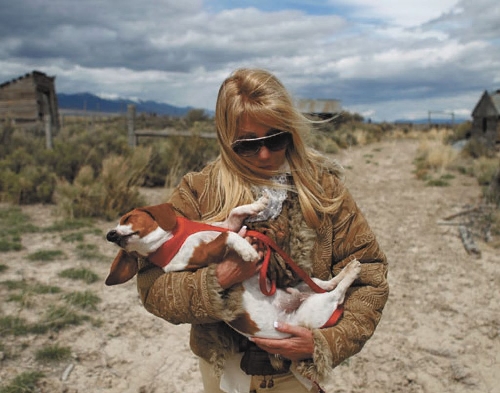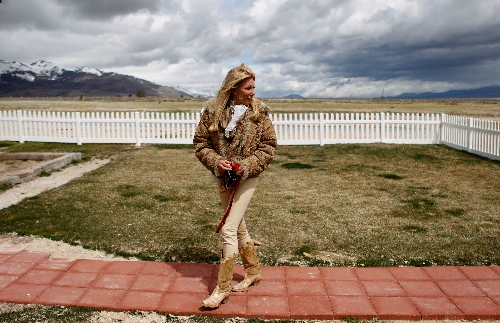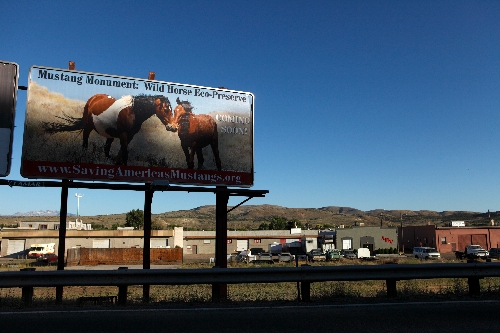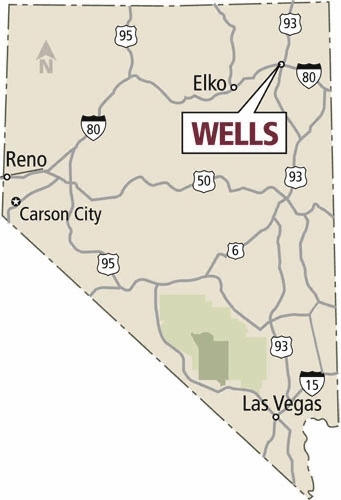Plans for Nevada wild horse eco-sanctuary pick up speed
Madeleine Pickens' plan to create a tourist-friendly eco-sanctuary for wild horses in northeast Nevada moved closer to reality Thursday as the Bureau of Land Management selected her "Mustang Monument" for an environmental review needed for final approval.
The BLM move came several years after the wife of Texas billionaire T. Boone Pickens first proposed holding wild horses on vast public and private land she purchased near Wells, a small town at the junction of U.S. Highway 93 and Interstate 80, about 50 miles east of Elko.
Pickens wants to open the place to the public so thousands of visitors and tourists can enjoy the horses up close on her eco-sanctuary, which would be about half the size of Rhode Island.
"It's exciting," Pickens said in an interview after the BLM decision was announced. "We plan to entertain people and let them see what wild horses are like. This is not your average dude ranch."
Under the proposal, at least 900 horses would roam 530,000 acres of BLM-managed public land where Pickens bought grazing rights on the Spruce allotment, a former cattle ranch. The eco-sanctuary also would include about 14,000 acres of private land she purchased as a base property for the project.
The BLM would keep ownership of the wild horses while Pickens would maintain the rangeland, water wells and fencing for the herd, which would include nonreproducing geldings and mares.
Pickens' proposal submitted by her nonprofit Saving America's Mustang foundation was the only one that met BLM criteria for a public-private wild horse eco-sanctuary, the federal agency said. Last year, it put out a formal request for proposals nationwide, a year after first rejecting Pickens' plan.
The in-depth assessment of the project under the National Environmental Policy Act could take up to two years, the BLM said, adding it will involve "extensive public input." The aim of the environmental impact statement is to measure the "environmental, economic, social" and other effects on the land and community, the BLM said.
If given final approval, the agency would enter into a partnership with Pickens' nonprofit group and provide federal funding to help support the wild horses at a cost no greater than what the BLM spends to keep wild horses in long-term holding pastures in the Midwest, or $475 per horse per year.
"The selection of SAM's proposal for environmental analysis furthers our overall effort to improve management and control costs of the Wild Horse and Burro Program," said BLM Director Bob Abbey.
Under a 1971 federal law, the BLM is charged with protecting the nation's remaining wild horse herds, which are roaming 10 Western states. About 38,500 horses are estimated to be running wild in specially designated "management areas" of public land, with about half in Nevada.
The BLM has more than 47,000 wild horses in short- or long-term holding facilities after rounding them up over the objections of wild horse advocates. The agency argues too many of the animals on the public lands damage the environment through overgrazing and depletion of water resources.
As a result, agency holding costs have skyrocketed, accounting for $35.7 million of the BLM wild horse program's $75.8 million annual budget, 47 percent. The government is seeking to help cut costs, in part, by approving eco-sanctuary projects on public and private lands.
Pickens' proposal is the most ambitious, an eco-sanctuary stretching across harsh, sage-covered valleys and around majestic Spruce Mountain, which rises 10,000 feet. She plans to build an educational center for visitors that would teach children and adults about America's heritage, its cowboys and Indians, and the role mustangs - the nation's enduring symbol of freedom - played in helping explorers and pioneers settle the nation.
She said visitors could sleep in teepees on the range, take covered-wagon rides along routes used to settle the West, take photography classes, painting workshops and even creative writing classes.
Tourists who visit the Strip in Nevada and travel to the Grand Canyon in Arizona and Yellowstone National Park in Wyoming and parts of Montana and Idaho could drive a few hours further to explore the Mustang Monument as another major destination, Pickens figures.
The city of Wells is about 380 miles from Las Vegas, 430 miles from Yellowstone, 630 miles from the Grand Canyon and 180 miles from Salt Lake City in Utah.
Running through Wells, U.S. 93 stretches from Canada to Mexico while I-80 crosses the country from coast to coast.
"What would be more fun than stopping off at Mustang Monument?" Pickens asked. "It would be a fabulous trip that people from all over the world would want to take."
Pickens said she expects to open her eco-sanctuary by late next spring because she already owns 550 wild horses she is keeping on her property. She rescued them more than a year ago, saving them from slaughter after they were rounded up from the Paiute Indian Reservation at Pyramid Lake.
"I'm going forward with or without the government," she said of the eco-sanctuary project. "I put it there for the horses to have a safe place. And it will be there long after I'm gone."
In 2005, Pickens became an animal rights activists after helping rescue 800 dogs and cats from Hurricane Katrina in New Orleans. The former race horse owner subsequently got involved in protecting wild horses after learning some were being sold for slaughter despite laws to protect them.
Pickens said she hopes the Nevada sanctuary can support more than the initial 900 wild horses if improvements on the range and wells provide more food and water. She has spent millions of dollars already to buy land and improve it, including growing alfalfa fields and building water troughs.
"This is a massive solution, and we can let it grow and take in more horses," she said.
The city of Wells has welcomed the project, while Elko County officials and local ranchers have objected to using public lands for anything other than for grazing cattle and sheep.
Elko County Commissioner Demar Dahl, the most vocal critic, said local government will lose tax collections by turning a profitable cattle ranch into a nonprofit sanctuary getting government funding.
"The taxpayers are going to be compensating Madeleine Pickens for taking care of horses," Dahl said, adding such projects could change the ranching culture of rural Nevada. "If we start taking ranges away and replacing those with wild horse sanctuaries, it sets a really bad precedent."
J.J. Goicoechea, president of the Nevada Cattlemen's Association, said he is pleased the BLM will conduct a full environmental assessment to ensure the eco-sanctuary doesn't disturb the land and migratory patterns of rangeland animals such as mule deer, antelope and the sage grouse. Also, hunters, recreational public land users and others must be assured of access, he said.
"We just want to make sure there's no adverse environmental impact," Goicoechea said. "I'm not opposed to it, but we still have some definite reservations about the eco-sanctuary."
Wells Mayor Ken Huff said he can't wait for wild horse tourists to start coming to boost the economy of the town of 1,500 people. Already, the city sees lots of pass-through traffic, boasting three casinos and three truck stops that cater to motorists and long-haul truckers stopping for gas and food.
"If there's a horse sanctuary 25 miles down the road, that's something that can draw them to stop for a while," Huff said. "For some, a Mustang Monument might be a once-in-a-lifetime thing to see."
Contact Laura Myers at lmyers@reviewjournal.com or 702-387-2919. Follow @lmyerslvrj on Twitter.
WILD HORSES
Unbridled Passions, Untamed Costs
Videos, slide shows, stories




















